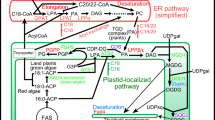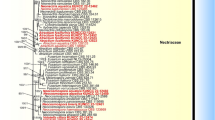Abstract
The orderCaryophyllales (Centrospermae) was found to contain specific P-type sieve-element plastids which are characterized by protein inclusions composed of ring-shaped bundles of filaments and of central crystalloids. The sieve-element plastids of 14 families (140 species investigated) fit into this overall characterization, and more specific details are used to delimit the families and arrange them within the order.Phytolaccaceae, the basic family of the order display much diversity: the crystalloids inside their plastids are either globular (most genera) or polygonal (Stegnosperma), starch may also be present (Phytolacca).Nyctaginaceae, with starch inBougainvillea sieve-element plastids, can be derived directly fromPhytolacca. Globular crystalloids are present in most of the families, as inDidiereaceae, Cactaceae, Aizoaceae-Tetragoniaceae, Portulacaceae-Basellaceae-Halophytaceae-Hectorellaceae. Caryophyllaceae andLimeum ofMolluginaceae contain polygonal crystalloids (otherMolluginaceae with globular crystalloids). Crystalloids are entirely absent fromChenopodiaceae (incl.Dysphaniaceae) andAmaranthaceae. The probable relationships between these families are presented diagrammatically in Fig. 13.
Bataceae, Gyrostemonaceae, Vivianiaceae, Theligonaceae, Polygonaceae, Plumbaginaceae, Fouquieriaceae, Frankeniaceae, andRhabdodendraceae—all at some time included into theCaryophyllales (Centrospermae) or doubtfully referred to them—develop S-type (or different P-type) sieve-element plastids. Their direct connection to theCaryophyllales therefore is excluded. Finally, evolutionary trends of theCaryophyllales are discussed.
Similar content being viewed by others
References
Arsanto, J.-P., 1970: Infrastructures et différenciation du protophloème dans les jeunes racines du Sarrasin (Polygonum fagopyrum, Polygonacée). C. R. Acad. Sci. D270, 3071–3074.
Behnke, H.-D., 1969a: Ultrastructure of angiosperm sieve-tube plastids in relation to systematics. Abstr. XIth Intern. Bot. Congr. (Seattle) p. 12.
—, 1969b: Über Siebröhren-Plastiden und Plastidenfilamente derCaryophyllales. Untersuchungen zum Feinbau und zur Verbreitung eines weiteren spezifischen Plastidentyps. Planta (Berl.)89, 275–283.
—, 1971: Sieve-tube plastids ofMagnoliidae andRanunculidae in relation to systematics. Taxon20, 723–730.
—, 1972: Sieve-tube plastids in relation to angiosperm systematics.—An attempt towards a classification by ultrastructural analysis. Bot. Rev.38, 155–197.
—, 1973: Plastids in sieve elements and their companion cells. Planta110, 321–328.
—, 1974a: Elektronenmikroskopische Untersuchungen an Siebröhren-Plastiden und ihre Aussage über die systematische Stellung vonLophiocarpus. Bot. Jahrb. Syst.94, 114–119.
Behnke, H.-D., 1974b: Sieve-element plastids ofGymnospermae: Their ultrastructure in relation to systematics. Plant Syst. Evol.123, 1–12.
—, 1975a: The bases of angiosperm phylogeny: ultrastructure. Ann. Missouri Bot. Gard.62, 647–663.
, 1975b: P-type sieve-element plastids: A correlative ultrastructural and ultrahistochemical study on the diversity and uniformity of a new reliable character in seed plant systematics. Protoplasma83, 91–101.
—, 1975c:Hectorella caespitosa: Ultrastructural evidence against its inclusion intoCaryophyllaceae. Plant Syst. Evol.124, 31–34.
—, 1975d: Die Siebelement-Plastiden derCaryophyllaceae, eine weitere spezifische Form der P-Typ Plastiden bei Centrospermen. Bot. Jahrb. Syst.95, 327–333.
—, 1975e: Elektronenmikroskopische Untersuchungen zur Frage der verwandtschaftlichen Beziehungen zwischenTheligonum undRubiaceae: Feinbau der Siebelement-Plastiden und Anmerkungen zur Struktur der Pollenexine. Plant Syst. Evol.123, 317–326.
—, 1976: Sieve-element plastids ofFouquieria, Frankenia (Tamaricales), andRhabdodendron (Rutaceae), taxa sometimes allied withCentrospermae (Caryophyllales). Taxon25, 265–268.
Behnke, H.-D., Chang, C., Eifert, I. J., andMabry, T. J., 1974: Betalains and P-type sieve-tube plastids inPetiveria andAgdestis (Phytolaccaceae). Taxon23, 541–542.
— andMabry, T. J., in press: S-type sieve-element plastids and anthocyanins inVivianiaceae: Evidence against its inclusion intoCentrospermae. Plant Syst. Evol.
,, Eifert, I. J., andPop, L., 1975: P-type sieve-element plastids and betalains inPortulacaceae (includingCeraria, Portulacaria, Talinella). Canad. J. Bot.53, 2103–2109.
—, andTurner, B. L., 1971: On specific sieve-tube plastids inCaryophyllales. Further investigations with special reference to the Bataceae. Taxon20, 731–737.
Bortenschlager, S., 1967: Vorläufige Mitteilungen zur Pollenmorphologie in der Familie derGeraniaceae und ihre systematische Bedeutung. Grana Palynol.7, 400–468.
—, andSimonsberger, P., 1972: Pollenmorphology of theAchatocarpaceae (Centrospermae). Ber. mat.-med. Ver. Innsbruck59, 7–14.
Cole, G. T., andBehnke, H.-D., 1975: Electron microscopy and plant systematics. Taxon24, 3–15.
Cronquist, A., 1968: The Evolution and Classification of Flowering Plants. Nelson: London.
Crookston, R. K., andOzbun, J. L., 1975: The occurrence and ultrastructure of chloroplasts in the phloem parenchyma of leaves of C4 dicotyledons. Planta123, 247–255.
Delay, C., andDarmanaden, J., 1973: Association entre les caractères morphologiques de la variété horticole « minor » d'Opuntia subulata et la présence de microorganismes de type mycoplasme dans le phloème. Étude experimentale et infrastructurale. Ann. Sci. Nat., Bot., 12e sér.14, 407–464.
Eckardt, T., 1964:Centrospermae. — In:Englers Syllabus der Pflanzenfamilien. II. Band, Angiospermen, S. 79–101. Berlin: Borntraeger.
Eckardt, T., 1971: Anlegung und Entwicklung der Blüten vonGyrostemon ramulosus Desf. Bot. Jb.90, 434–446.
Ehrendorfer, F., 1971:Spermatophyta. In: Lehrbuch der Botanik für Hochschulen, S. 584–745. 30. Aufl., Stuttgart: Fischer.
Eichler, A. W., 1876: Syllabus der Vorlesungen über Phanerogamenkunde. Kiel: Schwer'sche Buchhandlung.
Esau, K., 1965: Fixation images of sieve-element plastids inBeta. Proc. nat. Acad. Sci. (Wash.)54, 429–537.
Falk, H., 1964: Zur Herkunft des Siebröhrenschleimes beiTetragonia expansa Murr. Planta60, 558–567.
Hofmann, U., 1973: Centrospermenstudien. 6. Morphologische Untersuchungen zur Umgrenzung und Gliederung der Aizoaceen. Bot. Jahrb. Syst.93, 247–324.
Hunziker, J. H., Behnke, H.-D., Eifert, I. J., andMabry, T. J., 1974:Halophytum ameghinoi: a betalain-containing and P-type sieve-tube plastid species. Taxon23, 537–539.
Lefor, M. W., 1975: A taxonomic revision of theVivianiaceae. U. of Conn. Occasional Papers. Biol. Sci. Ser.2, 225–255.
Mabry, T. J., 1976: Pigment dichotomy and DNA-RNA hybridization data from centrospermous families. Plant Syst. Evol.126, 79–94.
—, andEifert, I. J., 1976: Betalains and P-type sieve-element plastids inGisekia L. (Centrospermae). Taxon25, 112–114.
—, andBehnke, H.-D., 1975:Theligonaceae: Pigment and ultrastructural evidence which exclude it from the orderCentrospermae. Biochem. Syst.3, 53–55.
—, andTurner, B. L., 1964: Chemical investigations of theBatidaceae. Betaxanthins and their systematic implications. Taxon13, 197–200.
Pax, F., andHoffmann, K., 1934:Caryophyllaceae. InEngler, A., undPrantl, K. (Eds.): Die natürlichen Pflanzenfamilien. 2. Aufl. pp. 275 to 364.
Prance, G. T., 1968: The systematic position ofRhabdodendron Gilg & Pilg. Bull. du Jardin Bot. Nat. de Belgique38, 127–146.
Takhtajan, A., 1973: Evolution und Ausbreitung der Blütenpflanzen. Stuttgart: Fischer.
Wunderlich, R., 1971: Die systematische Stellung vonTheligonum. Österr. Bot. Z.119, 329–394.
Author information
Authors and Affiliations
Additional information
Presented in the Symposium “Evolution of Centrospermous Families”, during the XIIth International Botanical Congress, Leningrad, July 8, 1975.
Rights and permissions
About this article
Cite this article
Behnke, H.D. Ultrastructure of sieve-element plastids inCaryophyllales (Centrospermae), evidence for the delimitation and classification of the order. Pl Syst Evol 126, 31–54 (1976). https://doi.org/10.1007/BF00986073
Received:
Issue Date:
DOI: https://doi.org/10.1007/BF00986073




